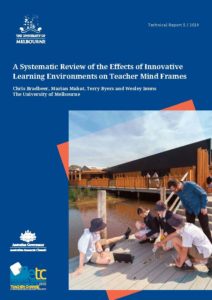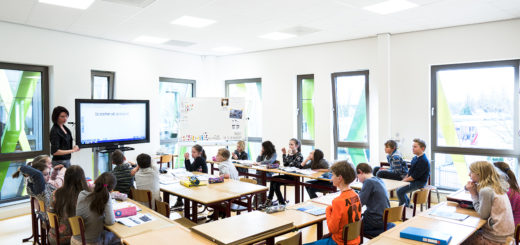A systematic review of the effects of innovative learning environments on teacher mind frames
The latest technical report, A systematic review of the effects of innovative learning environments on teacher mind frames, is now available for download here. This is the fifth in an ongoing series of technical reports aimed to collate and investigate a wide array of data gathered by the ILETC project. A brief overview of the systematic review is provided below.
 Aim: The overall objective of the systematic review was to identify studies which provide evidence that innovative learning environments have an effect on teacher mind frames. For this review, an innovative learning environment is defined as the product of innovative design of space and innovative teaching and learning practices (Mahat, Bradbeer, Byers & Imms, 2018). Innovative learning spaces are physical educational facilities designed and built to facilitate the widest array of flexibility in teaching, learning, and social educational activity, while innovative teaching and learning practices are the sum of teaching and learning activities that, in combination, assist in the best possible learning outcomes and learning skills of students required in the 21st century. An innovative learning environment is produced when these two phenomena are successfully merged. Teacher mind frames can be defined as the ways that teachers consciously think about their teaching roles, the content and pedagogical knowledge, which in turn has an impact on their attitudes, actions and decisions that are likely to have significant impacts on student learning (Mahat et al., 2018). Within these parameters, the review identified, collected and synthesised available literature that examined and evaluated the way primary and secondary school teachers considered their role, work, and practice in relation to learning environments.
Aim: The overall objective of the systematic review was to identify studies which provide evidence that innovative learning environments have an effect on teacher mind frames. For this review, an innovative learning environment is defined as the product of innovative design of space and innovative teaching and learning practices (Mahat, Bradbeer, Byers & Imms, 2018). Innovative learning spaces are physical educational facilities designed and built to facilitate the widest array of flexibility in teaching, learning, and social educational activity, while innovative teaching and learning practices are the sum of teaching and learning activities that, in combination, assist in the best possible learning outcomes and learning skills of students required in the 21st century. An innovative learning environment is produced when these two phenomena are successfully merged. Teacher mind frames can be defined as the ways that teachers consciously think about their teaching roles, the content and pedagogical knowledge, which in turn has an impact on their attitudes, actions and decisions that are likely to have significant impacts on student learning (Mahat et al., 2018). Within these parameters, the review identified, collected and synthesised available literature that examined and evaluated the way primary and secondary school teachers considered their role, work, and practice in relation to learning environments.
Method: The study adopted an interpretive approach but utilised the principles and techniques of conventional systematic review procedures involving 12 databases integrating fields of education and design. Eligible papers included those studies (quantitative, qualitative and mixed methods) that examined the impact of innovative learning environments on both primary and secondary school teacher mind frames from 1960 until 2016. The risk of sampling bias and quality of studies were assessed using the Cochrane Collaboration tool and the COnsensus-based Standards for the selection of health Measurement INstruments (COSMIN) checklist, respectively.
Results: Of the 2,943 studies retrieved, 12 were included in this review. Studies were published between 2000 and 2015 and applied different variations of conceptualisations of learning environments and teacher mind frames. For the most part, although innovative learning environments have a positive impact on teacher mind frames, there are intervening variables—the most significant being assessment regimes—that prevent teachers from engaging with or changing their practices in innovative learning environments.
Interpretation: The review presented very few studies with adequate quality, sampling and statistical evidence to evaluate the impact of different conceptualisations of learning environments on teacher mind frames. In particular, only one study investigated the impact of the physical space and only one study reported an effect size. In light of this, there is a pressing need to investigate the relationships between learning environments and the ways teachers actively think to guide, inform and frame their teaching practices.
References:
Mahat, M., Bradbeer, C., Byers, T., & Imms, W. (2018). Innovative Learning Environments and Teacher Change: Defining key concepts.



